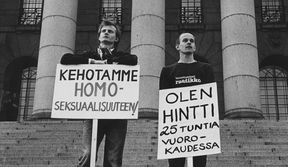Why do we still celebrate Pride?

The origins of Pride are tied to the 1969 Stonewall riots in New York. The riots began in the U.S. in a world where homosexuality was illegal in almost every state, with the police raiding Stonewall bar, which was a popular gathering place for the LGBTQ+ community. The bar’s clientele got tired of the arbitrary actions and violence of the police and began to riot against it.
So, Pride started as a protest against long-term oppression. Since then, the annual march has been organised to commemorate the uprising. In the march, we commemorate the oppression experienced by previous generations and their battle against it, without forgetting the present and the future.
Since the 1970s, the rainbow flag has been the common symbol of the LGBTQ+ community. The flag is a symbol of pride created by artist Gilbert Baker, with each of the original eight colours having its own meaning: hot pink representing sex, red life, orange healing, yellow sunlight, green nature, turquoise magic/art, indigo serenity and violet spirit. The rainbow flag was first raised at the Gay Freedom Day parade in San Fransisco in June 1978. Due to production difficulties, the flag was simplified to its current six colours.
In the 1960s and 1970s, the rights of the rainbow community began to take the first shaky steps in Finland as well. The first gay and lesbian movements were established and homosexual acts were decriminalised in 1971. However, a prohibition on promoting homosexual acts demanded by conservatives came into force, preventing the Finnish Broadcasting Company Yle from broadcasting programmes on sexual minorities.
Civil disobedience was a clever way to show the stupidity of the prohibition. In the 80s, rainbow activists proclaimed homosexuality in pride marches and made a number of criminal reports of themselves in which they confessed to publicly promoting homosexuality. In most cases, the judiciary considered the promotion to have been “forgivable thoughtlessness”.
Restaurants and bars have long offered the rainbow community the opportunity to meet each other and be themselves when the rest of society has not allowed it. In the 1960s, the establishment of an actual gay bar was not an option in Finland as the prohibition on promoting homosexuality was still in force. The establishment of a lesbian bar was even more impossible, as women were not even allowed to go to restaurants without male companion at the time.
Fortunately, society became a better place, but change does not happen on its own. The prohibition on promoting homosexuality was not removed until the year 1999. In the United States, a similar prohibition was not removed on the federal level until the year 2003. Many issues that are now self-evident have required an incredible amount of active requirement of rights and work from the LGBTQ+ community. Today in Finland, we are fortunate to have many associations that promote the rights of the rainbow community and provide a safe space. Nowadays, students have also established their own associations in various cities, such as Aalto’s very own GAYY of LGBTQ+ students founded in 2013.
But why do we still celebrate Pride 50 years later, isn’t everything okay now?
I dare to say no, everything’s not okay. Still, many sexual or gender minority people face hate speech or violence that leads some of them to hide their own identities.
LGBTQ+ rights need to be discussed and be more visible in different communities, so that all community members can be heard and feel safe. That’s why I find it important to raise an issue that may affect non-binary gender or transgender students throughout Finland: the Sisu system does not automatically provide an option to change your name.
This has led to ”deadnaming” of students in courses, i.e., the use of their old name, which is disrespectful and also a very personal issue. There have also been cases where a graduation certificate has included the old name instead of the current name. For this reason, changing one’s current name should be made easier in the future in order to avoid similar situations. Personally, I wonder why this issue was not taken into account in the planning phase of Sisu.
The entire GAYY Board would like to wish everyone a joyful Pride Month. The month includes a variety of events where you can be yourself in a safe space in the company of other rainbow people. We would like to remind all rainbow students that you have not come out of the closet but arrived at a community that accepts you just the way you are.
Text: GAYY Board 2022
Read more: https://sateenkaarihistoria.fi/aikajana/
Image source: https://www.flickr.com/photos/seta_ry/16289889981/
Read more news

AYY has sold the property at Kirkonkyläntie 16 to HKA Kiinteistöt Oy
The Aalto University Student Union (AYY) has sold the property it owned at Kirkonkyläntie 16. The real estate transaction was completed on December 19, 2025, and the buyer is HKA Kiinteistöt Oy.
An electronic certificate is coming, what does it mean for students?
As part of the digitalization process in Finland, Aalto University is switching electronic degree certificates. AYY has been advocating against the digital certificate, aiming to ensure a physical token to graduates.
Volunteers and positions of trust appointed for 2026
Aalto University Student Union has a wide range of volunteers working in sections, committees and other positions of trust. Volunteer recruitment is open annually from October to January. Volunteers appointed for 2026 will be announced on this page as the decisions are confirmed. Congratulations to new volunteers and thank you to all the applicants!
